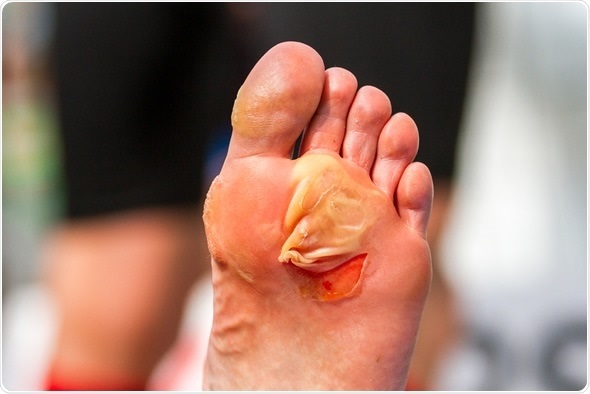
A foot blister is a fluid-filled pocket that develops in response to an infection or an injury, and it occurs in the top layer of the skin. Blister on foot happens over a damaged area to cushion the feet from further harm. Foot blister pain is because of the pressure on the feet.
Causes of blisters on the feet
Pressure and friction – When the feet continually rub against a rough surface, shoe, or socks it causes foot blisters. Inflammation and irritation result in redness, pain, and swelling. Initially, a red sore appears, then the body sends fluids to fill the opening to protect the underlying tissue layers that are delicate.
Burning – If the skin is burnt, the body responds by creating a blister to avoid further damage to the underlying tissues. Blisters develop after about two days but in severe burns, they appear immediately and the blister on foot heals when the burn itself heals.
Freezing – Frostbite happens in extremely cold conditions where the skin cells die and foot blisters form to keep the body warm and prevent further damage.
Medical conditions – Various medical conditions weaken the outer layer of the foot skin leaving it vulnerable to foot blisters. A blister can also signify infections, disorders, and diseases. These medical conditions include eczema, chickenpox, antibiotic treatment, blood-thinning medications, and being overweight.
Ruptured blood vessels – The tiny blood vessels in the epidermis of the skin break, they cause a blood blister. It occurs when the skin is pinched or crushed.
Contact dermatitis – Skin inflammation or dermatitis occurs when the foot skin is exposed to an irritant. If the exposure continues the condition progresses to form a blister on foot.
Other contact dermatitis foot blisters include
- Insect stings and bites.
- Skin allergens.
- Nickel
- Sulfates
- Toxic chemical agents.
Foot Blister Treatment
Foot blister pain can be very uncomfortable to live with. If you are experiencing pain with your foot blister, contact the podiatrist at DeNiel Foot & Ankle Center. Our doctor can provide the care you need to keep you pain-free and on your feet and it can heal in a few days.
Leave it alone – Blisters heal naturally and provide a safe space for healing allowing new skin to grow. After the new skin grows, the body slowly reabsorbs the fluid and the skin dries up and flakes off.
Protect it – Protect the blister to prevent it from popping to decrease the time it takes for it to heal. Avoid friction around the blister and cover it with a loose bandage to allow airflow necessary for drying out the blister. Use an adhesive bandage to secure it in position.
Cushion the blister with a cushioned adhesive bandage designed for blisters to reduce pain and keep out blisters as the blister heals.
Pad it with a moleskin that absorbs pressure to avoid putting it on the blister.
Draining a blister
If the blister is in an inconvenient place or it is large, a foot doctor can advise you to drain the blister. It is best to let your doctor drain the blister without damaging the covering of the blister. The draining is usually done within 24 hours after it forms.
When you notice that the blister has green or yellow fluid or the pain gets worse, or the area is hot to touch or inflamed, contact a podiatrist immediately for foot blister treatment. Also, if the blister keeps coming back, or the pain gets worse or it is a symptom of an allergic reaction a foot doctor will know how best to treat it.

